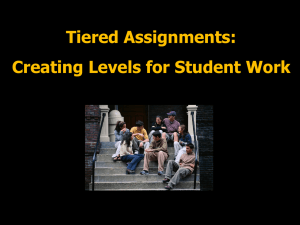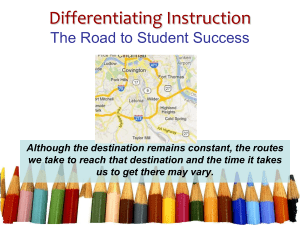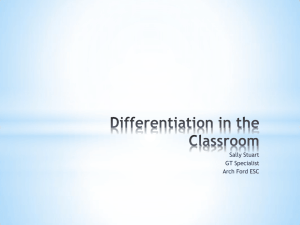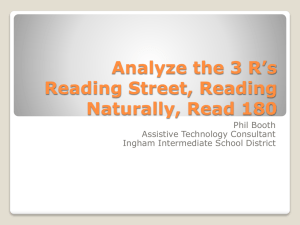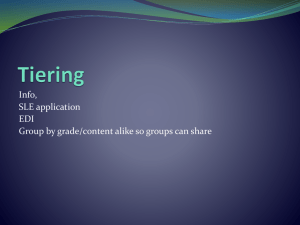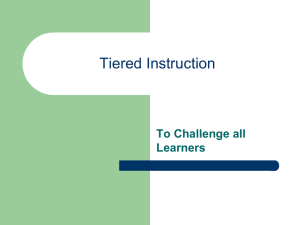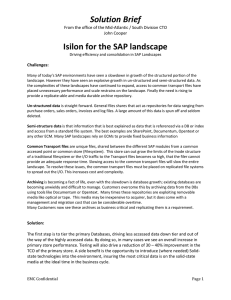Differentiation & Mathematics
advertisement
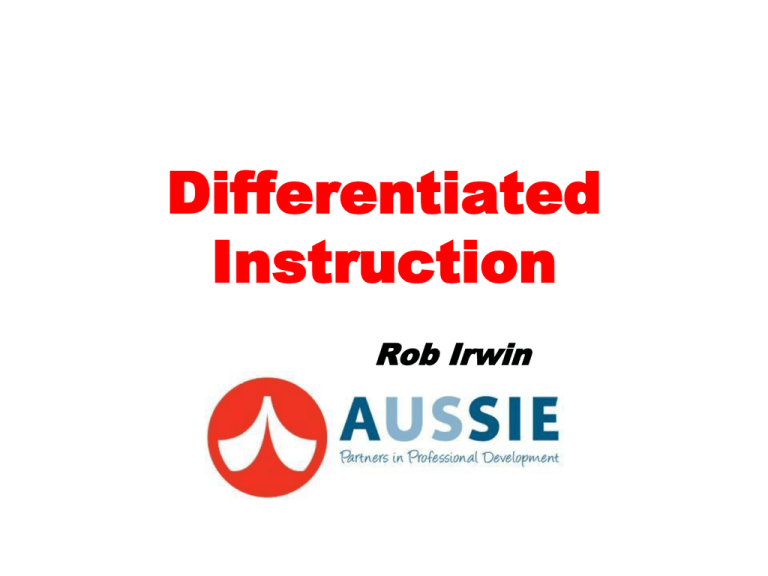
Differentiated Instruction Rob Irwin Purpose • Develop shared and practical understandings of differentiation as related to the effective teaching of Mathematics • Tiering as a differentiation strategy • Tiering Math Games & Trailblazers lessons Processes/Payoff • Processes: Question Car Park; Think, Pair, Share; Paired/ Quad Brainstorm; Games Rotations; Discussion; Gallery Walk; Group Planning • Payoff: Leave the workshop with practical ideas for differentiating instruction through the strategy of tiering Protocols for working as a professional learning community • Adopt a sense of responsibility for the group as a community of learners • One person at a time talking so as to keep the meaning • Attend to and listen to others • Accept where others are at • Suspend judgement • Allow and give no putdowns • Common signal for gaining everyone’s attention “Question Car Park” • Write down your questions and issues on the post-it notes provided throughout the sessions and “park” them in the “Question Car Park” charts on the walls of the room. • I will work at answering them at the beginning of the next two sessions. Treasure Hunt for Diversity Using the Treasure Hunt grid, complete each section by finding colleagues who match the description. Challenges of today’s students • As a group, brainstorm (and jot down in your reflective journals) all the needs of students you have worked with in your classrooms this year or in the past. Challenges of today’s students The diversity of students in your classroom: • “Learning styles (visual, spatial, auditory, tactile, kinaesthetic) • Interests • Strengths/ Weaknesses • Cognitive abilities • ELL’s • Attitudes/ Motivation/ Persistence/ Confidence • Readiness • Socio-Economic and Family Factors • Learning Pace • Gender Influences • Cultural/Ethnic influences Challenges of Today’s Students “Normal is only a setting on the washing machine” Schmidt, M (2006). Losing Sight of the Shore: Differentiating Curriculum and Instruction. A Once Upon A Time Story About A Blonde Student Once upon a time there was a lovely, young student named Goldilocks. She was an adventurous sort, so one day she went walking through the forest in search of a teacher. As Goldilocks rounded a bend in the path, she came into a bright clearing in the forest. She was very excited to find a teacher presenting a lesson that at first captured her attention. Goldilocks tried to stay engaged and learn, but she became frustrated as it was just too difficult. The story continues….. She sighed, waved goodbye to the first teacher, and continued on her way. Goldilocks walked a bit longer and ambled up a hill where she found herself in a wide, flower-filled pasture. There a second teacher sat, seemingly waiting just for her. This teacher began her lesson, but Goldilocks soon became bored because it was just too easy. She waved goodbye to the second teacher, and once again went on her way. The story continues…..again! • Trudging through the forest more slowly now and less joyfully, she came across a magnificent meadow that was not only amazingly colorful but fragrant as well. There stood another teacher. The teacher began the lesson, and Goldilocks was enthralled! This lesson wasn’t too hard! It wasn’t too easy! It was just right! What is Differentiation? Think, Pair, Share: • Individually, jot down your own thoughts as to what you think differentiation is. • Share with partner. • Share with group of 4. What is Differentiation? • At its most basic level, differentiating instruction means “shaking up” what goes on in the classrooms so that students have multiple options for taking in information, making sense of ideas and expressing what they learn…a differentiated classroom provides different avenues to acquiring content, to processing and making sense of ideas, and to developing products so that each student can learn effectively” (Carol Tomlinson, 1999, p. 1) How Is It Implemented? • Use diagnostic assessments to determine student readiness. These assessments can be formal or informal. Teachers can give pre-tests, question students about their background knowledge, or use KWL charts (charts that ask students to identify what they already Know, what they Want to know, and what they have Learned about a topic). How is it implemented? • Determine student interest. This can be done by using interest inventories and/or including students in the planning process. Teachers can ask students to tell them what specific interests they have in a particular topic, and then teachers can try to incorporate these interests into their lessons. How Is It Implemented? • Identify student learning styles and environmental preferences. Teachers can get information about student learning styles by asking students how they learn best and by observing student activities. Identifying environmental preferences includes determining whether students work best in large or small groups and what environmental factors might contribute to or inhibit student learning. For example, a student might need to be free from distraction. PLUS you need a good understanding of M.C. What Does it Look Like for Math? Math instruction can be differentiated to allow students to work on skills appropriate to their readiness level and to explore mathematics applications through - • Math games are a very good and easy way to differentiate learning. Played correctly students can experience fun activities while playing different levels of a game. • Tiering is another way. Tier the group or individual activities after the mini lesson. Differentiated Instruction is the proactive acceptance of and planning for student differences, including their readiness interests learning profiles Teachers can respond to student differences by differentiating content process products environment while always keeping in mind the guiding principles of respectful tasks ongoing assessment & adjustment flexible groups What is reality now and Where you want to be: Self-Assessment Traditional Classroom Vs Differentiated Classroom Using the handout, place an X on each continuum where you believe your teaching is now and a Y where you’d like to be. Discuss with your group. Tiering as a Differentiation Strategy: What is it? “Tiered activities are really quite essential. They are almost the meat and potatoes of differentiation.” (Tomlinson) Differentiating by Readiness/Tiered Lessons • Involves having students work on the same concept at different levels of complexity and with different levels of support or open-endedness. • Not more work or less work, just different work. Planning Tiered Assignments Concept to be Understood OR Skill to be Mastered Create on-level task first then adjust up and down. Below-Level Task On-Level Task “Adjusting the Task” Above-Level Task When Tiering: Adjust--• • • • • • • Level of Complexity Amount of Structure Materials Time/Pace Number of Steps Form of Expression Level of Dependence The “Equalizer” 1. Foundational Transformational 2. Concrete Abstract 3. Simple Complex 4. Fewer Facets * Low Readability Multi-Facets *High Readability 5. Smaller Leap Greater Leap 6. More Structured More Open 7. Clearly Defined Problems 8. Less Independence 9. Slower Fuzzy Problems Greater Independence Quicker Using “the Equalizer: A Tool for Planning Differentiated Lessons” (Tomlinson, 2000) • “Similar to using the equalizer buttons on a CD player/stereo, you can slide the buttons across several different continuums to get the best combination of sounds for a musical piece. • In a differentiated classroom, adjusting the buttons appropriately for various students’ needs equalizes their chances of being appropriately challenged by materials, activities, products in your classroom” (Tomlinson, 2000). What is Tiered Instruction? Teachers use tiered activities so that all students focus on essential understandings and skills but at different levels of complexity, abstractness, and openendedness. By keeping the focus of the activity the same, but providing routes of access at varying degrees of difficulty, the teacher maximizes the likelihood that: 1) each student comes away with pivotal skills & understandings 2) each student is appropriately challenged. Use of State Standards Use the standards (current state standards or Common Core standards) to inform the tiering by seeing the sequence of development of the concept Tiering Let’s look at how to tier a game Importance of teachers knowing content & Standards Let’s look at and then later play… Flash HANDOUT IN FOLDER Now consider this…. Tier 1: One group of students in the class are very unsure of the basic Count-On (count on 1,2,3,0) facts Tier 2: One group of students in the class may need to practice doubles Tier 3: One group of students in the class have automaticity with addition facts to 12, including Make Ten strategy WHAT TO DO? Differentiate the Game using the Equalizer: Addition Flash Tier 1: John, Robyn, Liz, Rob, Karen Unsure of very basic count-on facts Count-on 1,2,3,0 •Foundational •Less independence •Simple •Observation notes •Exit slips Play game with doubles dominoes •Concrete •Game recording slips •Observation notes •Journal * Play game with different numbers (2x6 sided dice; cards 0-12) * Missing addend game * 3 addend game •Transformational •Game recording slips •Observation notes •Journal Choose specific cards/ specific dice (e.g. +1, +2,+3,+0 – singly or combinations of count-on facts based on students’ needs) Use of visuals (number line) Play game Count-On 1, 2, 3, 0 Tier 2: Judith, Barry, Kate, Jessica, Richie Need to develop strategy of doubles facts Tier 3: Dan, Angie, Peter, Jacinta, Mia •Multiple facets •Complex Tiered Games: Let’s Experience It Flash Activity Cont. Work with a partner # 1 Sequence the games in order of development # 2 Find as many activities that you could differentiate into 3 tiers Let’s Experience It • You are going to participate in several games that have been tiered at three different levels. 1. Your group needs to play each tier of each game. Compare the three tiers. What is the big math idea? 2. Complete the template, match each tiered set of games to the Standards and the Equalizer 3. What are the implications for your own classroom? Carousel the Games Around the Groups/Tables We’ll move the games on a given signal clock-wise Table 1: Table 2: Table 3: Table 4: Table 5: Table 6: Tiered Games Group Report • What did you notice? Differentiate the Games using the Equalizer- It’s your turn! • Each group will find a Math game, planning template and butcher’s paper on their table. • As a group and using the ‘Equalizer’ and the Standards in your handout, adapt the game and plan for a variety of students’ needs- tier for three groups of children • Tape your group’s poster up for the gallery walk Gallery Walk • One member from each group stays with the tiered games poster. • All groups rotate and the poster leader describes the tiering. • Ask questions • Get ideas • Complete template • Rotate on given signal Tiering a Daily Math Lesson in the Workshop Model Tiering the Student Activity Portion of the Workshop Model Lesson Whole Math Message/Warm-Up Whole * Mini-Lesson Part Whole Student ActivityGroup 1 Group 2 Group 3 * Share Time Tiering a Trailblazer Lesson Your Turn… Using the template in your packet, choose some lessons from the program (eg. first weeks of school in September) and, consulting the standards, tier the student activity portion of each lesson How do I begin to differentiate? • Consider Low Prep/High Prep differentiation • See handout on “Hints to Begin” Let’s Recap Explicit Visuals of ExpectationsY Chart - Kindergarten Establishing a Co-operative FrameworkDeveloping a Y Chart for Group Work Flexible GroupsDifferentiated Games Using Assessment to Inform the Differentiation within each Game Varying Content of Games to Meet Students’ Needs Rubric for Differentiation (developed by Julie Howie A.U.S.S.I.E. Math Consultant) • Use for reflecting on your practice Things Take Time Put up in a place where it’s easy to see, The cryptic admonishment, T.T.T. When you feel how depressingly slow you climb It’s well to remember that THINGS TAKE TIME. From Tomlinson, C. Evaluation Form Thank-you for your participation today Please complete the evaluation form HAVE A GREAT NEW SCHOOL YEAR!
